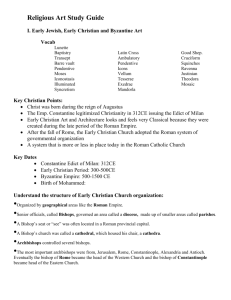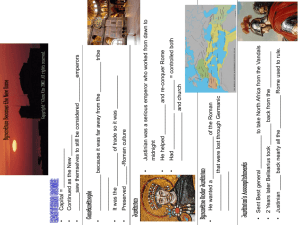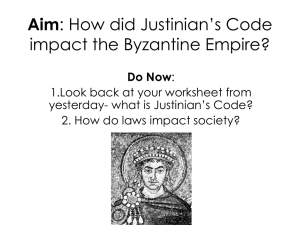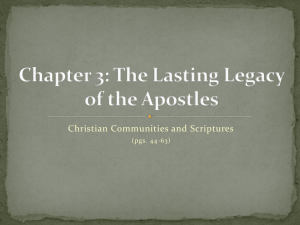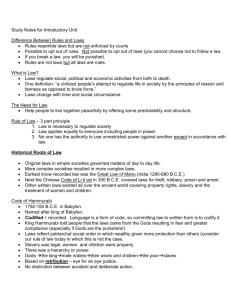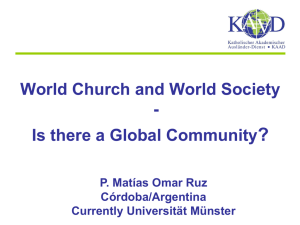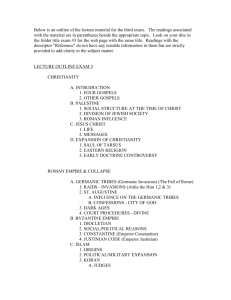RELS_735: BOOK REVIEW – ESSAY SUMMARY_LJB0208
advertisement
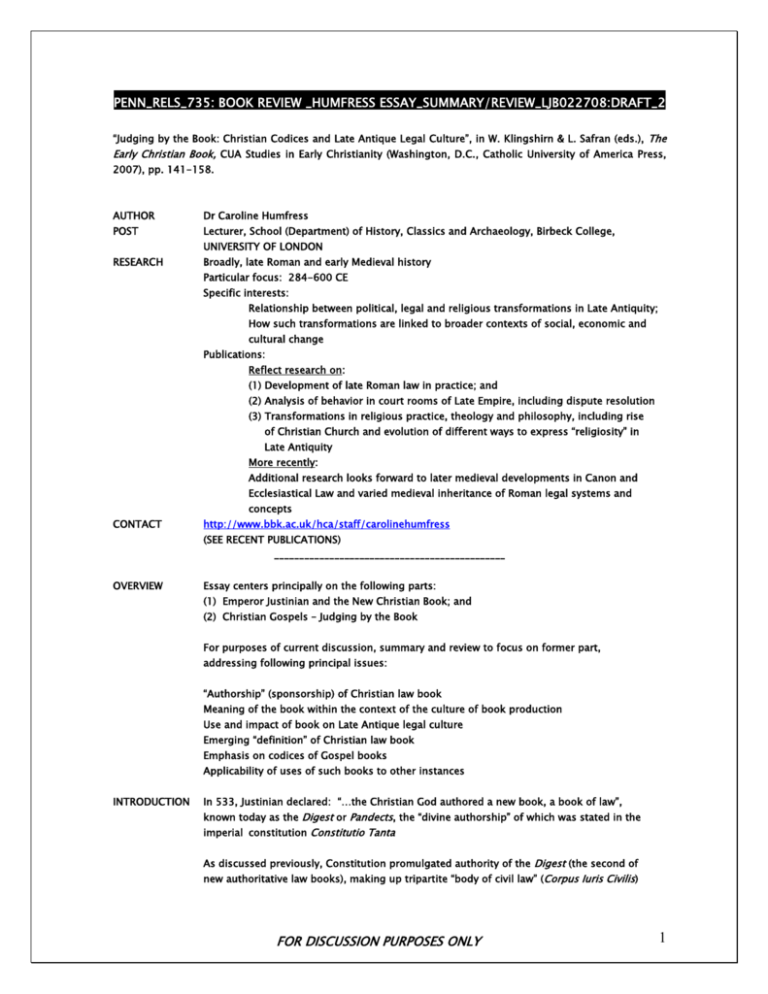
PENN_RELS_735: BOOK REVIEW _HUMFRESS ESSAY_SUMMARY/REVIEW_LJB022708:DRAFT_2 “Judging by the Book: Christian Codices and Late Antique Legal Culture”, in W. Klingshirn & L. Safran (eds.), The Early Christian Book, CUA Studies in Early Christianity (Washington, D.C., Catholic University of America Press, 2007), pp. 141-158. AUTHOR Dr Caroline Humfress POST Lecturer, School (Department) of History, Classics and Archaeology, Birbeck College, UNIVERSITY OF LONDON RESEARCH Broadly, late Roman and early Medieval history Particular focus: 284-600 CE Specific interests: Relationship between political, legal and religious transformations in Late Antiquity; How such transformations are linked to broader contexts of social, economic and cultural change Publications: Reflect research on: (1) Development of late Roman law in practice; and (2) Analysis of behavior in court rooms of Late Empire, including dispute resolution (3) Transformations in religious practice, theology and philosophy, including rise of Christian Church and evolution of different ways to express “religiosity” in Late Antiquity More recently: Additional research looks forward to later medieval developments in Canon and Ecclesiastical Law and varied medieval inheritance of Roman legal systems and concepts CONTACT http://www.bbk.ac.uk/hca/staff/carolinehumfress (SEE RECENT PUBLICATIONS) ______________________________________________ OVERVIEW Essay centers principally on the following parts: (1) Emperor Justinian and the New Christian Book; and (2) Christian Gospels – Judging by the Book For purposes of current discussion, summary and review to focus on former part, addressing following principal issues: “Authorship” (sponsorship) of Christian law book Meaning of the book within the context of the culture of book production Use and impact of book on Late Antique legal culture Emerging “definition” of Christian law book Emphasis on codices of Gospel books Applicability of uses of such books to other instances INTRODUCTION In 533, Justinian declared: “…the Christian God authored a new book, a book of law”, known today as the Digest or Pandects, the “divine authorship” of which was stated in the imperial constitution Constitutio Tanta As discussed previously, Constitution promulgated authority of the Digest (the second of new authoritative law books), making up tripartite “body of civil law” (Corpus Iuris Civilis) FOR DISCUSSION PURPOSES ONLY 1 Opening sentence of constitution: “So great is the providence of the Divine Humanity toward us that it ever deigns to sustain us with acts of eternal generosity.” Such acts of “eternal generosity” include: End of the Parthian wars Extinction of the Vandal nation Reconquest of Libya for Empire Further to considering creation of a single “harmonious” text of juristic opinions, Justinian observes: “… We, therefore, in our accustomed manner have resorted to the aid of the Immortal One and, invoking the Supreme Deity, have desired that God should become the author and patron of the whole work..” PROJECT Project involved collection, emendation, and reduction of nearly 2,000 separate books and more than 3 million lines of text written by classical jurists into 50 books of the Digest; Completion of the volume being attributed to “…(the) inspiration of heaven and favor of the Supreme Trinity.” Humfress (“C/H”, “author”) maintains that by confirming Digest’s “authority” issued “In the Name of Our Lord God Jesus Christ”, Justinian effected rhetorical “Christianization” of all non-Christian classical juristic books contained within it. Digest called a “Christian Law Book” despite paradoxical fact that its 50 books contained no clearly stated Christian precepts whatsoever. Thus, C/H maintains that Christian “authority” of Digest was not achieved by Christianization of principles of classical Roman jurisprudence; rather, it was created by “…enveloping classical books of Roman jurists WITHIN A NEW ORDER OF TEXTS.” C/H suggests that Digest serves as a “…salutary reminder” of how meaning of texts can be altered by their COPYING, RESTRUCTURING, AND COMPLEX “SHUFFLING … INTO A NEW MONUMENTAL PHYSICAL FORM.” Indeed, during 5th/6th centuries, evidence of same process of “textual monumentalizing” observed re Judeo-Christian texts; (cite examples in which books were collected and ordered into new pandect forms: Codex Sinaiticus, Codex Vaticanus, Codex Alexandrinus) Argued that specific use of codex form for copying of early Christian texts “…acted as inspiration to later codification of Roman law.” BOOK C/H cites only direct comparison between form of early Christian book and form of late PRODUCTION Roman legal codex derives from observation of mid-5th century ecclesiastical writer, Sedulius. Drew analogy between three editions of Origen’s Hexapla and Hermogenian’s Opera (cf. “Hermogenian” legal code) Points toward “symbiotic culture of book production and revision” as opposed to any causal relationship between “Christian” and “Roman” legal texts Further to seminar’s more recent discussion (cite: Wieaker) on general culture of book production, argued that development of codex book form (in both Christian and Roman legal texts) should be considered as EXPRESSION OF A DEFINITE LATE ANTIQUE CULTURAL FOR DISCUSSION PURPOSES ONLY 2 STYLE (CHARACTERISTIC/AESTHETIC), CHARACTERIZED BY A NEW RELATIONSHIP TO THE WRITTEN, TRANSMITTED WORD SYMBOLIC Codex book could be “…closed and its front and back covers lavishly ornamented: thus, VALUE symbolic of a new culture of written language and a new conception of the authority and value of the text.” Justinian’s 6th century “codification” project took transformation of late Roman legal culture a step further: Justinian’s insistence on Christian God’s involvement in the production of the Corpus Iuris Civilis directly influenced by Justinian’s own conception of his “imperial theocracy” … JUSTINIAN NO LESS RELATED TO GOD THAN WERE THE TEXTS HE PROVIDED (!) “SACREDNESS” C/H interestingly comments that it is “…tempting to note…divine aid allegedly supplied by the Holy Spirit to the Justinianic legal commissioners was curiously analogous to the miraculous divine aid attributed ... to the 70 (or 72) Hebrew translators of the biblical Septuagint text.” Augustine refashioned legend in late 4th century following dispute with Jerome re translation of Vulgate OT books from Hebrew rather than Greek; per Augustine: “…translators owed no human bondage to the original Hebrew words being translated as the divine power of the Holy Spirit filled and ruled the mind that was translating…” C/H maintains that for Augustine, Holy Spirit “…animated both Hebrew prophets and 70 Hellenistic translators”; and, devout translators who produced Greek Septuagint were “…liberated by the Holy Spirit”, owing no “slavish bondage” to the original Hebrew text; accordingly, new text of Septuagint viewed as SACRED AND DIVINELY SANCTIONED LEGAL Justinian’s legal officials expected to be familiar with concept that “…physical presence of APPLICABILITY particular Christian codices ACTUALLY INVOKED THE SPIRITUAL PRESENCE OF GOD” Too, believed that such codices “… LITERALLY INVOKED GOD AS A VIRTUAL PARTICIPANT IN LEGAL TRIALS UNDER JUSTINIAN’S JURISDICTION” C/H cites ‘clever effect’ in ~530 constitution re “contumacious proceedings” (i.e., trials where one of litigants was absent). Per Justinian: When a copy of scripture is present in courtroom, absence of litigant is to be understood as “… remedied by the presence of God” Emperor “neatly extricates himself from conflict” of Roman law and Christian Canon law: TRADITIONAL ROMAN PROCEDURAL REGULATIONS ALLOWED CONTUMACIOUS PROCEEDINGS, WHEREAS ECCLESIASTICAL PRACTICE INSISTED THAT DEFENDANTS SHOULD NOT FORFEIT THEIR CASES UNHEARD C/H argues that Justinian manages to uphold both Roman and Canon law by SUBSTITUTING GOD FOR THE ABSENT DEFENDANT, GOD’S PRESENCE BEING GUARANTEED BY SACRED SCRIPTURES THEMSELVES In constitutions published in same year (Cod. Iust. 3.1.14), C/H further points out Justinian ordered that “…every judge who decides cases according to Roman Law must not start FOR DISCUSSION PURPOSES ONLY 3 proceedings until a copy of the Sacred Scriptures has been placed before the judge in the tribunal hall, where it was to remain until after the sentence had been delivered.” As a result, Justinian would often terrify his legal officials by reminding them that they might judge now, but they will be judged in turn (!) Thus, late Roman judges were to proceed “BY THE BOOK” (of Sacred Scriptures), although they themselves would be judged by the same book (!) Justinian’s “eschatological threat of future judgment” similarly leveled against litigants, their advocates, and their witnesses (per Byzantine papyrological reports of courtroom proceedings) Importantly, given centrality of texts and that act of judging was fundamental tenet of Judeo-Christian tradition, C/H poses following question: WHAT BOOK – EXACTLY – WAS TO BE PLACED BEFORE EVERY JUDGE WHO HEARD CASES “ACCORDING TO ROMAN LAW” IN AGE OF JUSTINIAN ? “THE BOOK,” To modern eyes, term “Sacred Scriptures” (Scripturae Sacrosanctae) might suggest placing EXACTLY of a pandect Bible – containing OT and NT – in every courtroom C/H maintains from two later Justinianic constitutions (NEED TO IDENTIFY) – each dealing with the same provision in different contexts – that “Sacred Scriptures” refers here to GOSPELS in particular Thus, phrase Scripturae Sacrosanctae clarified – if not, displaced by – phrase Sacrosanctis Evangeliis Later constitution (issued ~537) allows Senate in Constantinople the right of hearing cases on appeal “… in the presence of the Holy Gospels” As a result, copy of GOSPELS was to be placed before senators, as well as magistrates and other legal arbitrators C/H indicates that Justinianic constitutions relating to procedural oath-swearing regularly specify that such oaths are to be made “…WHILE TOUCHING GOSPEL BOOKS (Sacrosanctis Evangeliis Tactics)” Before a trial can take place, “…advocates on both sides shall be sworn with their hands upon Holy Gospels” NOTE: Such emphasis on GOSPELS in legal context recorded by Procopius, Secret History (Anekdota; publication date: 550, 558, or 562) According to Precopius, Justinian forced to abjure his faults to Constantinopolitan subjects during NIKA Riots (532) by an oath sworn while touching a GOSPEL codex in public arena of the Hippodrome Author concludes that copies of GOSPELS, rather than pandect copies of the Bible (Scripturae Sacrosanctae) in general were given “…preeminent status in early 6th century legal contexts FOR DISCUSSION PURPOSES ONLY 4 WHAT ARE WE TO CONCLUDE CONCERNING EMPHASIS ON GOSPEL CODICES IN PARTICULAR ? GOSPEL C/H indicates Justinian’s stress on GOSPEL books reflects Church’s own formalization of it BOOKS conciliar and liturgical practices Council at Chalcedon (451) was conducted with a copy of the GOSPELS at the assembly’s center, as Nicea (325) When the “…GOSPELS are present, so too is the Lord” (as taken from liturgy of Divine Service): Upon reading of GOSPEL, “…presiding bishop rises up and lays aside his stole ( omophorion), thus signifying that Lord Himself – author of pastoral function – his God and Master,” is present Codices of “four-in-one” GOSPELS (Gospel “Harmonies”, e.g., Diatesseron) had already acquired “symbolic status” in relations between the Church and Empire during reign of Constantine C/H maintains that Constantine asked Eusebius of Caesarea to furnish him with 50 copies of GOSPELS (not the Bible) in Greek for use in the new city of Constantinople (NEEDS CONFIRMATION) Within broader issue of surviving MSS, C/H refers to relatively higher survival rate of GOSPEL books in relation to other ‘scriptural’ books from Late Antiquity SELF-IDENTITY In symbolic sense, Gospel books were books of Jesus Christ par excellence; used to differentiate between Jewish and Christian identity C/H refers to widespread cultural phenomenon, that of “…ascribing identity through deliberate choice of possessing a collection of particular books” Notion that “identity” could be constructed by mere possession of particular “books” (? SCROLLS) was not new: In late 2nd century, Sophist Lucian lampooned “ignorant book collectors” who thought mere possession of “handsome volumes” guaranteed place among social elite C/H refers to identity differences between Jews and Christians as being made “…materially concrete” in the presence of the book of Gospels CAN JUSTINIAN’S INSISTENCE ON PARTICULAR USE OF GOSPELS IN LEGAL CONTEXTS BE UNDERSTOOD IN OTHER INSTANCES ? INFAMY: Justinian’s Novel 146 seeks to regulate use of Sacred Scripture in Jewish synagogues; preface NOVEL 146 opens as follows: “Necessity dictates that when the Hebrews listen to their sacred texts they should not confine themselves to the meaning of the letter, but should also devote their attention to those sacred prophecies which are hidden from them, and which announce the mighty Lord and Saviour Jesus Christ.” Drafters were primarily concerned with converting Jews into Christians; indeed, Section I. of Novel 146 specifies that Jewish congregations must not use Sacred Scriptures in Hebrew, but must use translations either in Greek or from other translations in Latin, “…or any other tongue.” FOR DISCUSSION PURPOSES ONLY 5 “And the Mishnah, or as they call it the second tradition, we inhibit entirely, it being profane and mundane, having nothing of the divine in it.” Mishnah was thus forbidden in synagogues, and sacred “Hebrew” books which remain licit (i.e., equivalent to Christian OT) are no longer to be read in Hebrew Justinian concludes that “…every Jew will have the chance to read, interpret, and understand Sacred Scripture for themselves without having to rely upon Hebrew teachers.” I THUS, JUSTINIAN ATTACKS POWER STRUCTURE AND SELF-IDENTITY OF JEWISH COMMUNITIES THROUGH DEFINING AND REGULATING THE COMMUNITY OF BOOKS THEY ARE TO USE REVELATION, Outstanding reference in Justinian’s Novel 146 to treatment of Hebrew Scriptures as CO-OPTED “…prophetic revelation” has long, complex and contentious history across range of JudeoChristian contexts C/H reminds us that by 4th century, exegetical techniques for treating Hebrew Scriptures as PROPHETIC REVELATION OF LATER CHRISTIAN EVENTS were well developed Christian identity could be claimed by “Judaic” books of Holy Scripture; treated by Christian communities as “Christian Books” PARTICULAR SOURCE OF CONTENTION: HOW SHOULD AN ASPIRING MODEL CHRISTIAN READ (AND, PARTICULARLY TO ACT UPON) THOUSANDS OF LITERAL, SPECIFIC, AND BINDING MOSAIC LAWS IN GENESIS, EXODUS, LEVITICUS, NUMBERS, AND DEUTERONOMY) CHALLENGES POSED COULD, OR SHOULD, LATE ANTIQUE CHRISTIANS CONCEIVE OF A CONCRETE “LEX CHRISTIANA” A CHRISTIAN “LAW” BASED ON THE NT THAT COULD STAND OVER AND AGAINST JUDAIC LEX DEI ? DID LATE ANTIQUE CHRISTIANS (AND/OR NON-CHRISTIANS) CONCEIVE OF THE GOSPELS AS THE SOURCE OF A SPECIFIC, WRITTEN AND BINDING CHRISTIAN LEX ? WERE GOSPEL TEXTS, IN EFFECT, TREATED AS BOOKS OF CHRISTIAN LAW ? AND, MORE BROADLY, TO WHAT EXTENT WAS SACRED SCRIPTURE CONSIDERED AUTHORITATIVE “LEGAL TEXT” THAT COULD BE CITED IN CASES AT LAW ? HOW WERE BOOKS OF SACRED SCRIPTURE MANAGED UNDER VARIOUS ECCLESIASTICAL AND SECULAR (FORENSIC) CONTEXTS UP TO THE AGE OF JUSTINIAN ? L J Botticelli February 27, 2008 ljbotticelli@gmail.com FOR DISCUSSION PURPOSES ONLY 6
